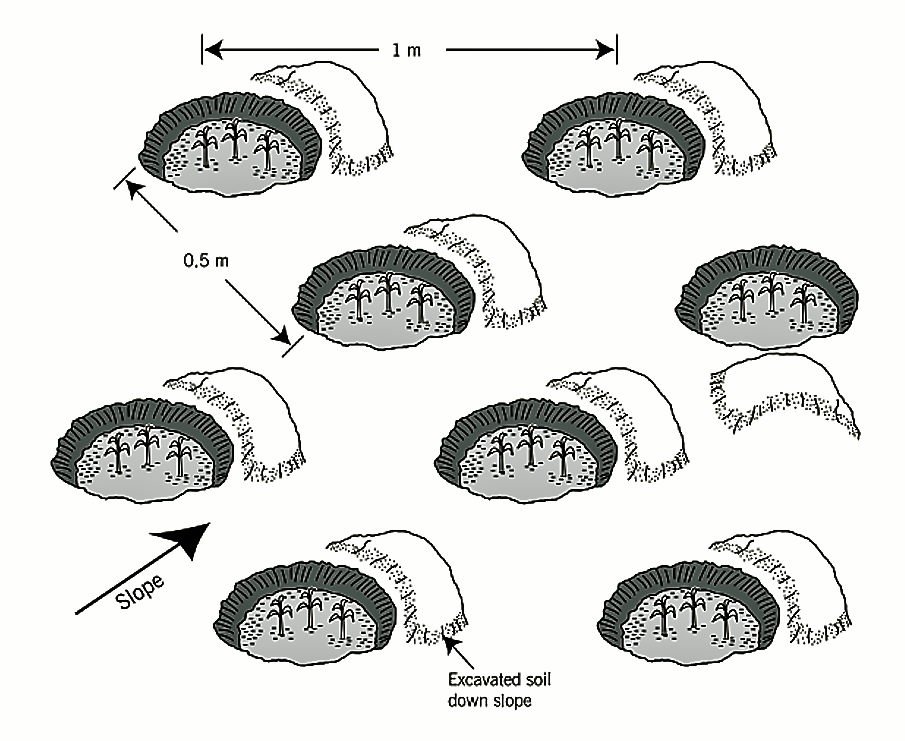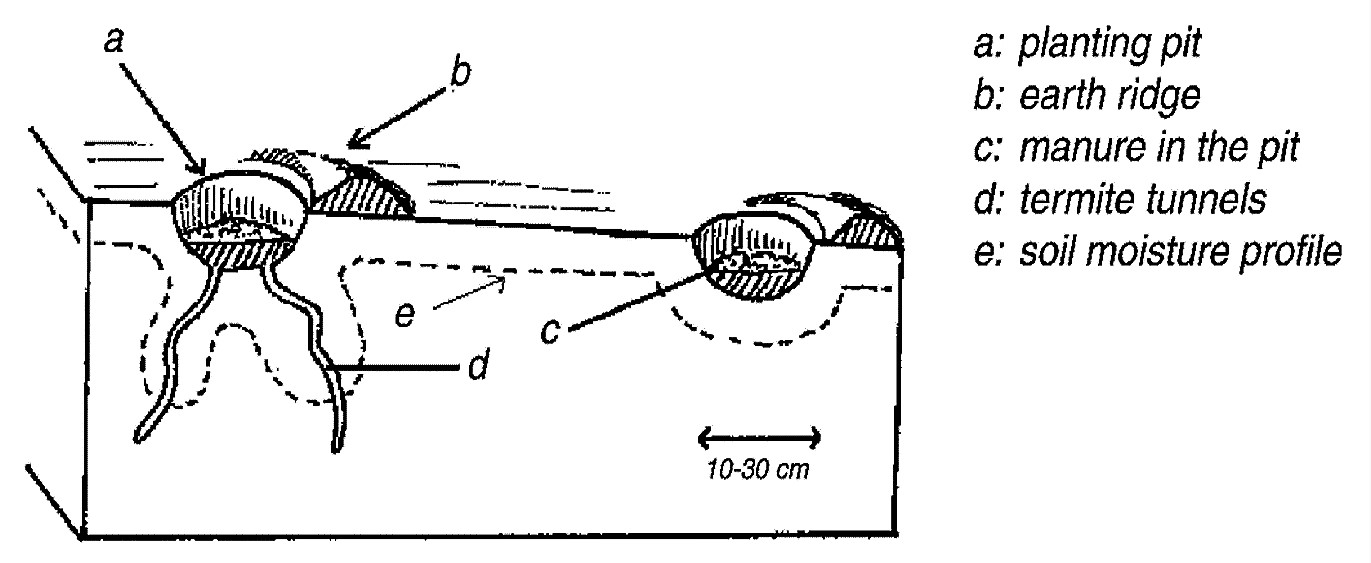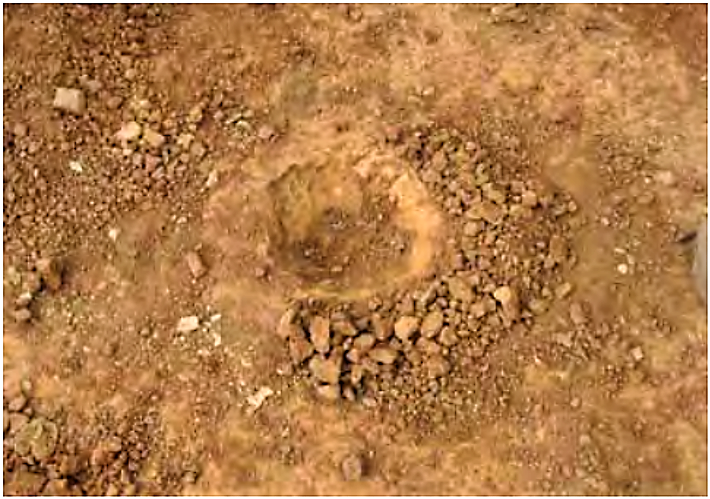Executive Summary
Planting pits are used as a precipitation harvesting method to prevent water runoff and thereby increase infiltration and reduce erosion. Basically, holes are dug 50-100 cm apart from each other with a depth of 5-15 cm in order to prevent water runoff. Planting pits are most suitable on soil with low permeability, such as silt and clay. They are applicable for semi-arid areas for annual and perennial crops (such as sorghum, maize, sweet potato, bananas, etc.). One main advantage is their simple implementation and maintenance (ADB 2008).
| In | Out |
|---|---|
Precipitation, Freshwater, Compost/Biosolids |
Freshwater, Food Products |
Introduction
Planting pits are the simplest form of in situ rainwater harvesting for optimising crop production (see also bunds, field trenches, micro basins, retention basins, and controlled drainage) (ANSCHUETZ et al. 2003). Basically, holes are dug 50-100 cm apart from each other with a depth of 5-15 cm in order to prevent water runoff.
This form of micro-catchment is best suited for land with low permeability, such as silt and clay soils. On encrusted soils, three types of conservation practises can be met with planting pits: soil conservation, water and soil moisture conservation, and erosion protection (see also soil degradation) (UNEP 2012). To further increase crop production, organic matter (such as compost or manure) can be placed in the pits as fertiliser (see also conservation tillage, soil cover and reforestation, soil amendment, mulching and use of compost).
Many different names are used for planting pits, such as Zaï (Zay), Chololo, Mantengo, Ngoro and Tassa (ADB 2008; UNEP 2012). They are widely applied in Sahelian countries, such as Mali, Burkina Faso, and in the Yatanga and Niger regions.
Basic design principles
Adapted from ANSCHUETZ et al. (2003) & ADB (2008)
Planting pits have a very simple design:

The diameter of the pits is usually between 15 and 50 cm (depending on the soil structure), but they sometimes also exist in much greater sizes. The depth of each pit should be between 5 and 15 cm. Planting is best done in straight rows or along the contour lines (see also contour bunds) with a distance of 50-100 cm between each pit. This equals 10,000-25,000 pits per hectare. If the soil is already very shallow, planting on the top of the ridges can be beneficial, as the soil may be too shallow for crops to grow within the holes.
To further improve crop growth, fertiliser, such as compost or manure (see also mulching and use of compost), can be placed in the pits. When heavy rainfall occurs, the organic matter can additionally help to soak up excess water, preventing unwanted water accumulation.
In combination with stone lines, planting pits can be used to rehabilitate degraded and crusted land. The stone lines are spaced at a distance of 25 to 50 m and help to further hold back moisture and eroded soil (see also soil degradation) (WOCAT 2007).

Cost considerations
Adapted from ADB (2008)
Most costs arise because of the time needed for digging the holes and filling them with organic matter. They are therefore strongly dependent on the structure of the soil. Roughly 20 to 70 person days per hectare are needed for digging the holes and another 20 person days are required for fertilisation. Usually, no equipment costs arise, because digging can be done with common tools already available.
Operation and maintenance
Adapted from ANSCHUETZ et al. (2003)

Digging the pits should be done during dry season, so that the pits are ready when the rainy season begins. In the second year of implementation, new pits need to be dug in order to retain the soil’s fertility.
Weeding is not necessary, because vegetation growth is unlikely to occur on the degraded soil between the pits. When excavating the pits, the excess soil is embanked downslope of the pit to further stop water runoff.
At a Glance
| Working principle | Planting pits collect runoff water in order to increase provided water for various crops planted within or close to them and to prevent soil degradation. |
| Capacity/adequacy | They are best suited for soils with low permeability, such as clay and silt. |
| Performance | Simple measure to stop surface run-off, increase soil moisture and prevent erosion. |
| Costs | Costs are highly dependent on the soil’s structure. Approximately 30-70 person days are needed per hectare. |
| Self-help compatibility | Due to their simple design, planting pits can well be done without expert knowledge. |
| O&M | The construction of planting pits should be done during the dry season. Each year, new pits have to be dug in order to recover the soil’s fertility. |
| Reliability | High. |
| Main strength | Planting pits are very easy to implement. They are well suited for land with low permeability as they increase soil infiltration. |
| Main weakness | As the construction of planting pits cannot be mechanised, it needs high human labour input. |
Planting pits are most suitable on soil with low permeability, such as silt and clay. They are applicable for semi-arid areas for annual and perennial crops (such as sorghum, maize, sweet potato, bananas, etc.). Due to their easy application and quickly observable improvement of crop growth, the implementation of planting pits is usually well adopted by farmers.
Rainwater Harvesting Handbook. Assessment of Best Practices and Experience in Water Harvesting
The main objective of this handbook on rainwater harvesting is to provide the African Development Bank with an effective reference tool for including various rain water harvesting approaches and techniques in the programming and design of projects.
ADB (2008): Rainwater Harvesting Handbook. Assessment of Best Practices and Experience in Water Harvesting. Tunis-Belvedere, Tunisia: African Development Bank (ADB) URL [Accessed: 04.10.2013] PDFWater Harvesting and Soil Moisture Retention
The water harvesting techniques described in this booklet are particularly useful in arid and semi-arid areas, but the techniques described for soil moisture conservation are also of use in sub-humid regions.
ANSCHUETZ, J. KOME, A. NEDERLOF, M. NEEF, R. de VEN, T. van de (2003): Water Harvesting and Soil Moisture Retention. Wageningen: Agromisa Foundation URL [Accessed: 06.08.2012] PDFGreen Water Management Handbook. Rainwater Harvesting for Agricultural Production and Ecological Sustainability
This handbook highlights the principles and technologies that can be used to harness the huge untapped potential of rainwater. Instead of a stereotyped view focusing only on rivers and groundwater, the book directs readers in recognising rain as the ultimate source of water for food production and other uses in rural economies across Africa.
MALESU, M.M. ; ODUOR, A.R. ; ODHIAMBO, O.J. (2007): Green Water Management Handbook. Rainwater Harvesting for Agricultural Production and Ecological Sustainability. Nairobi: The World Agroforestry Centre URL [Accessed: 13.03.2019] PDFSourcebook of Alternative Technologies for Freshwater Augmentation in Africa. Planting Pits
Water Harvesting and Conservation
Introduction to different water harvesting techniques for agriculture, delivering short summaries of each method.
HDRA (n.y): Water Harvesting and Conservation. Coventry: Henry Doubleday Research Association (HDRA) International Development Programme PDFWater Harvesting
Water harvesting has been practiced successfully for millennia in parts of the world – and some recent interventions have also had significant local impact. Yet water harvesting’s potential remains largely unknown, unacknowledged and unappreciated. These guidelines cover a wide span of technologies from large-scale floodwater spreading to practices that collect and store water from household compounds.
MEKDASCHI STUDER, R. LINIGER, H. (2013): Water Harvesting. Guidelines to Good Practice. Bern/Amsterdam/Wageningen/Rome: Centre for Development and Environment (CDE), Rainwater Harvesting Implementation Network (RAIN), MetaMeta, The International Fund for Agricultural Development (IFAD) URL [Accessed: 12.03.2019] PDFRainwater Harvesting Technologies for Agricultural Production. A Case for Dodoma, Tanzania
This paper presents different rainwater harvesting methods applied in Dodoma Region in Tanzania.
HATIBU, N. MAHOO, H. (1999): Rainwater Harvesting Technologies for Agricultural Production. A Case for Dodoma, Tanzania. In: KAMBUTHO, P.G. ; SIMALENGA, T.E. ; (1999): Conservation Tillage with Animal Traction. Harare, Zimbabwe: . URL [Accessed: 26.11.2012] PDF

